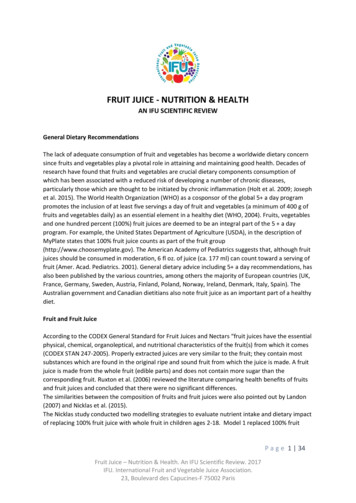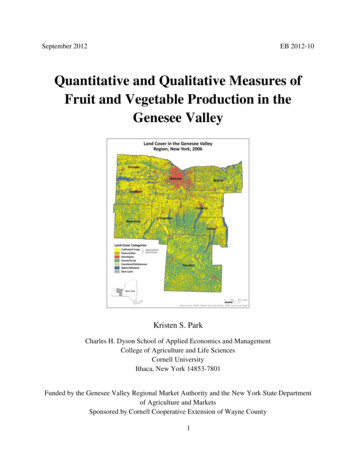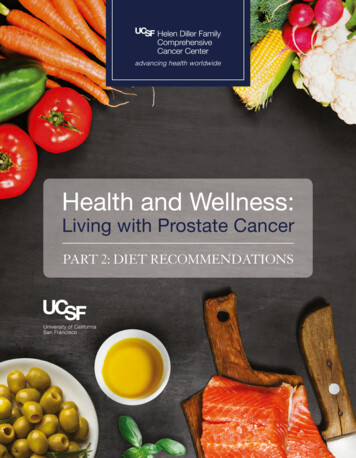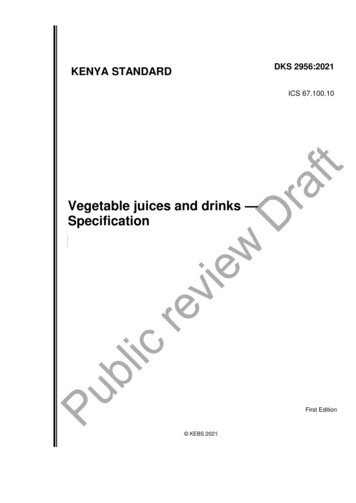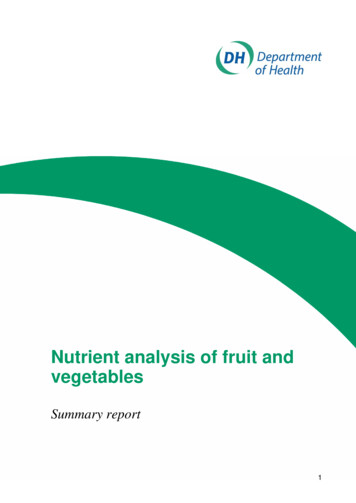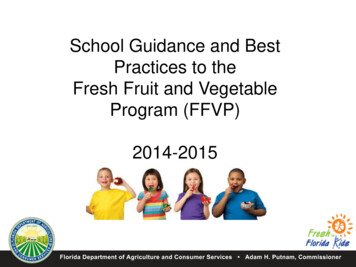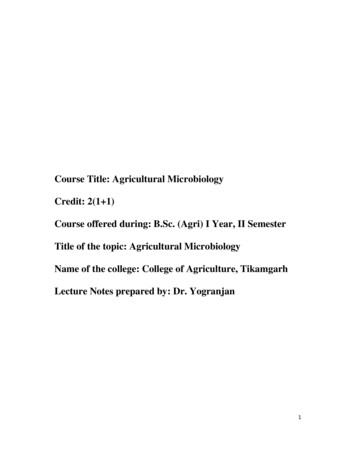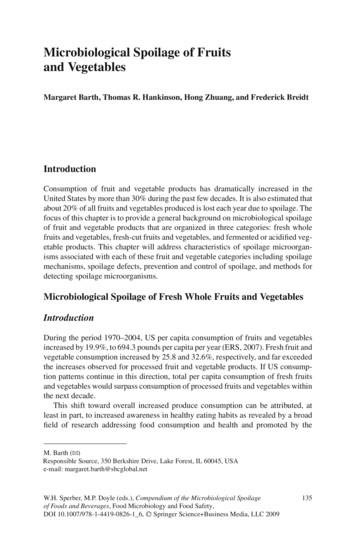
Transcription
Microbiological Spoilage of Fruitsand VegetablesMargaret Barth, Thomas R. Hankinson, Hong Zhuang, and Frederick BreidtIntroductionConsumption of fruit and vegetable products has dramatically increased in theUnited States by more than 30% during the past few decades. It is also estimated thatabout 20% of all fruits and vegetables produced is lost each year due to spoilage. Thefocus of this chapter is to provide a general background on microbiological spoilageof fruit and vegetable products that are organized in three categories: fresh wholefruits and vegetables, fresh-cut fruits and vegetables, and fermented or acidified vegetable products. This chapter will address characteristics of spoilage microorganisms associated with each of these fruit and vegetable categories including spoilagemechanisms, spoilage defects, prevention and control of spoilage, and methods fordetecting spoilage microorganisms.Microbiological Spoilage of Fresh Whole Fruits and VegetablesIntroductionDuring the period 1970–2004, US per capita consumption of fruits and vegetablesincreased by 19.9%, to 694.3 pounds per capita per year (ERS, 2007). Fresh fruit andvegetable consumption increased by 25.8 and 32.6%, respectively, and far exceededthe increases observed for processed fruit and vegetable products. If US consumption patterns continue in this direction, total per capita consumption of fresh fruitsand vegetables would surpass consumption of processed fruits and vegetables withinthe next decade.This shift toward overall increased produce consumption can be attributed, atleast in part, to increased awareness in healthy eating habits as revealed by a broadfield of research addressing food consumption and health and promoted by theM. Barth (B)Responsible Source, 350 Berkshire Drive, Lake Forest, IL 60045, USAe-mail: margaret.barth@sbcglobal.netW.H. Sperber, M.P. Doyle (eds.), Compendium of the Microbiological Spoilageof Foods and Beverages, Food Microbiology and Food Safety,C Springer Science Business Media, LLC 2009DOI 10.1007/978-1-4419-0826-1 6, 135
136M. Barth et al.National Cancer Institute with the 5-A-Day Challenge along with the USDA-revisedFood Pyramid. Additional factors influencing greater fresh produce consumptionare the increased availability of fresh produce throughout the country throughout the year, increased diversity of selection at the retail level (Kaufman, Handy,McLaughlin, Park & Green, 2001), and rapid growth in the fresh-cut, ready-to-eatproduce sector (see “Microbiological Spoilage of Fresh-Cut Fruits and Vegetables”).According to a USDA-Economic Research Service study in 1995, 18.9 billionpounds of fresh fruits and vegetables were lost annually due to spoilage, whichwas 19.6% of all US losses of edible foods that year (Kantor, Lipton, Manchester,& Oliveira, 1997). The portion of loss specifically due to microbiological spoilagewas not reported.Most microorganisms that are initially observed on whole fruit or vegetablesurfaces are soil inhabitants, members of a very large and diverse community ofmicrobes that collectively are responsible for maintaining a dynamic ecological balance within most agricultural systems. Vectors for disseminating these microbesinclude soil particles, airborne spores, and irrigation water. Most bacteria and fungithat arrive on the developing crop plant either are completely benign to the crop’shealth or, in many instances, provide a natural biological barrier to infestation bythe subset of microorganisms responsible for crop damage (Janisiewicz & Korsten,2002, Andrews & Harris, 2000). The even smaller subset of bacteria and fungiresponsible for causing spoilage to the edible portion of the crop plant is the subjectof this section.Spoilage microorganisms can be introduced to the crop on the seed itself, during crop growth in the field, during harvesting and postharvest handling, or during storage and distribution. Those same types of soil-borne spoilage microbes thatoccur on produce are the same spoilage microorganisms that are present on harvesting equipment, on handling equipment in the packinghouse, in the storage facility, and on food contact surfaces throughout the distribution chain. Therefore, earlyintervention measures during crop development and harvesting through the use ofgood agricultural practices (GAP) will provide dramatic reductions in yield lossdue to spoilage at all subsequent steps in the food-to-fork continuum (Eckert &Ogawa, 1988). Examples of GAPs include foliar fungicide application in the field,cross-contamination prevention measures (stringent sanitation standard operatingprocedures) in the packinghouse and storage facility, and use of postharvest fungicides. These practices also will enhance substantially the food safety and shelflife of fresh-cut produce (see “Microbiological Spoilage of Fresh-Cut Fruits andVegetables”).In 1998, FDA published the Guide to Minimize Microbial Food Safety Hazardsfor Fresh Fruits and Vegetables, recommending GAPs that growers, packers, andshippers implement to address the common microbiological hazards that may beassociated with their operations (FDA, 1998). These GAPs are organized in eightcategories:I. WaterII. Manure and municipal biosolids
Microbiological Spoilage of Fruits and VegetablesIII.IV.V.VI.VII.VIII.137Worker health and hygieneSanitary facilitiesField sanitationPacking facilities sanitationTransportationTracebackIn addition, FDA worked with the produce industry to develop commodityspecific food safety guidelines for sprouts, lettuce and leafy greens, melons, andtomatoes that provided metrics for soil and water amendments as well as adjacent land usage. In March 2007, FDA issued a draft final version of its “guide”(FDA, 2007). These should also improve substantially the food safety and shelflife of fresh-cut produce (see “Microbiological Spoilage of Fresh-Cut Fruits andVegetables”).Unusual Characteristics of Spoilage MicroorganismsMany fruits and vegetables present nearly ideal conditions for the survival andgrowth of many types of microorganisms. The internal tissues are nutrient rich andmany, especially vegetables, have a pH near neutrality. Their structure is comprisedmainly of the polysaccharides cellulose, hemicellulose, and pectin. The principalstorage polymer is starch. Spoilage microorganisms exploit the host using extracellular lytic enzymes that degrade these polymers to release water and the plant’sother intracellular constituents for use as nutrients for their growth. Fungi in particular produce an abundance of extracellular pectinases and hemicellulases that areimportant factors for fungal spoilage (Miedes & Lorences, 2004). Some spoilagemicrobes are capable of colonizing and creating lesions on healthy, undamaged planttissue (Tournas, 2005b). Spoilage microorganisms also can enter plant tissues during fruit development, either through the calyx (flower end) or along the stem, orthrough various specialized water and gas exchange structures of leafy matter. Successful establishment, however, requires the spoilage microbe to overcome multiplenatural protective barriers. Fruits and vegetables possess an outer protective epidermis, typically covered by a natural waxy cuticle layer containing the polymercutin (Lequeu, Faucconnier, Chamma, Bronner, & Blee, 2003). A diverse community of epiphytic microorganisms that present a further competitive barrier to thespoilage organism also typically colonizes the outermost fruit surface. Overcomingthese barriers requires an exquisite set of biochemical tools that allow the spoilagemicroorganism to (1) identify and recognize the plant surface; (2) employ one ormore strategies to achieve irreversible attachment to the plant surface; and (3) initiate steps leading to internalization of the tissue (Mandrell, Gorski & Brandl, 2006).On plant structures other than the fruit, internalization can be achieved througha number of specialized vessels and surface structures employed by the plant toabsorb and release water and to provide CO2 and O2 exchange (Bartz, 2006).
138M. Barth et al.Table 1 Bacterial fruit pathogensa2004 Annual USper capitaconsumption domonasErwiniaXanthomonasAcidovorax a Importantb 85.2%postharvest diseases retrieved from Sholberg et al. (2004) and other sources.of all fresh fruits consumed per capita in the United States in 2004 (ERS, 2007).However, the fruit of the plant lacks many of these structures, requiring the spoilagemicrobe to employ other methods to become internalized (Lindow & Brandl, 2003;Agrios, 1997). This may partially explain the rather limited success of bacteria tospoil fruits (Table 1) and an improved ability to spoil vegetables that are not thefruit of the plant (Table 3). The natural acidity of most fruits also serves as a barrier to many spoilage microbes, especially bacteria. By contrast, spoilage fungi thattypically produce more diverse and greater amounts of extracellular depolymerasessuccessfully attack and spoil both fruits and vegetables (Tables 2 and 4).Colonization and lesion development more typically and more rapidly occurswithin damaged or otherwise compromised plant tissue. External damage such asbruising, cracks, and punctures creates sites for establishment and outgrowth of thespoilage microbes. Lesion development can be relatively rapid, occurring withindays or weeks. This presents the risk that rapidly reproducing spoilage microorganisms will arrive within open wound sites at the packing facility, and thereby,through shedding from the asymptomatic wound, present the potential for crosscontamination within the facility during handling, culling, washing, sorting, andpacking before storage. Such cross-contamination to some degree is inevitable and,if not carefully managed with a robust facility sanitation program, could lead tothe establishment of a population of spoilage microbes endemic to the facility thatmay be difficult to eradicate. A further and potentially more serious complication isthe introduction into the cold storage facility of spoilage microorganisms alreadyestablished in wound sites on product, whether the product is in bins or boxedand palletized. Depending upon storage conditions and storage time (greater than12 months for certain robust crops), and if not carefully managed, these “primed”spoilage microorganisms can have a devastating impact on the stored product.Apples, for example, are stored in very large, controlled atmosphere storage rooms,either in wooden bins or boxed and ready for distribution (Watkins, Kupferman, &Rosenberger, 2004).
b 85.2%18.825.86.122.77.914.75.13.14.4 Botrytis Geotrichum Fusarium Penicilliumpostharvest diseases retrieved from Sholberg et al. (2004) and other sources.of all fresh fruits consumed per capita in the United States in 2004 (ERS, 2007).a chesPearsPineapple2004 Annual U.S.per capitaconsumption (lbs)b Colletotrichum MucorTable 2 Fungal fruit pathogensa Monilinia Rhizopus PhtyophthoraMicrobiological Spoilage of Fruits and Vegetables139
b 81.0%5.98.38.99.66.322.512.02.621.746.52.119.3 Erwinia Pseudomonas Xanthomonaspostharvest diseases retrieved from Sholberg et al. (2004) and other sources.of all fresh vegetables consumed per capita in the United States in 2004 (ERS, 2007).a ImportantBroccoliCabbageCarrotsCorn, sweetCucumbersLettuce, headLettuce, leafMushroomsOnionsPotatoesSpinachTomatoes2004 Annual USper capitaconsumption (lbs)bTable 3 Bacterial vegetable pathogensa Bacillus Clostridium Lactic acidbacteria140M. Barth et al.
Microbiological Spoilage of Fruits and Vegetables141Fig. 1 Extensive blue moldinfestation on applesTwo wound pathogens, Penicillium expansum and Botrytis cinerea, if not scrupulously cleaned from fruits prior to storage or if fruits with infected wounds have notthoroughly been culled from the lot, can cause significant crop loss as these spoilagefungi eventually degrade the wound sites, create lesions, and cross-contaminateadjacent fruits. If fruits receive improper preharvest fungicide application, poorwashing, and/or inadequate culling, an expanding infestation of spoilage microorganisms can destroy a substantial portion of a stored lot of fruits (Figs. 1 and 4).P. expansum (Miedes & Lorences, 2004) and B. cinerea (van Kan, 2006) arepathogens of apples, pears, and a number of other pectin-rich fruits. B. cinereais an especially sophisticated and selective plant pathogen that possesses multiplecutinases and lipases that are capable of degrading plants rich in pectin (van Kan2006).The bacterium Erwinia carotovora subsp. carotovora is a highly effectivespoilage microbe that causes soft rot across a broad host range of vegetables andsome fruits (Lund, Baird-Parker, & Gould, 1983; Table 4). One of six knowngenera of soft-rot bacteria (including Xanthomonas, Pseudomonas, Clostridium,Cytophaga, and Bacillus), E. carotovora subsp. carotovora is one of several speciesof Erwinia that infect and destroy plant tissues both pre- and postharvest and is thespecies that causes the greatest damage to harvested vegetables. Soft rot is a formof decay characterized by a watery transparency in infected leafy plant parts and
b 81.0% 12.02.621.746.52.119.3 6.322.55.98.38.99.6Geotrichum Rhizopus Phytophthora Fusariumpostharvest diseases retrieved from Sholberg et al. (2004) and other sources.of all fresh vegetables consumed per capita in the United States in 2004 (ERS, 2007).a nachTomatoes2004 Annual USper capitaconsumption (lbs)b PythiumTable 4 Fungal vegetable pathogensa Alternaria Colletotrichum Botrytis Sclerotinia142M. Barth et al.
Microbiological Spoilage of Fruits and Vegetables143watery disintegration of nonleafy plant materials. “Soft-rot erwinia” tend to initiate infection and decay at wound sites and, once established, can quickly advanceto total destruction of the product. Soft-rot erwinia express four pectin-degradingextracellular enzymes: pectin lyase, polygalacturonase, pectin methylesterase, andpectate lyase. Of these enzymes, pectate lyase is primarily responsible for extensivedecay. E. carotovora has built-in redundancy for this apparently critical pathogenicity factor, expressing four distinct extracellular pectate lyase isozymes (Barras, vanGijsegem, & Chatterjee, 1994).Soft-rot erwinia are active only at temperatures of 20 C and above, which reinforces the need to maintain a continuous cold chain from immediately postharvest toretail to successfully manage this ubiquitous spoilage bacterium. Another group ofsoft-rotting bacteria, the fluorescent pseudomonads (i.e., Pseudomonas fluorescensand Pseudomonas viridiflava), can decay plant tissue at temperatures at or below4 C. This is one explanation for the high prevalence of these bacteria on decayedvegetables at wholesale and retail markets (Liao & Wells, 1987). Liao, Hung, &Chatterjee (1988) revealed through several P. viridiflava mutants defective in pectate lyase expression that these mutants completely lost the ability to induce soft roton potato tuber slices. The soft-rotting fluorescent pseudomonads, when consideredtogether with soft-rot erwinia, present a formidable challenge to commercial freshproduct operations, and fresh vegetables in particular, from the farm to retail andwholesale outlets.Pseudomonas tolaasii, another fluorescent pseudomonad and fresh producespoilage bacterium, has a much narrower range of host-specificity than P. fluorescens and P. viridiflava. P. tolaasii causes spoilage of the white mushroom,Agaricus bisporus. Similar to P. fluorescens and P. viridiflava, P. tolaasii producessiderophores that fluoresce under ultraviolet light (Munsch, Geoffroy, Alatossans,& Meyer, 2000). However, unlike the soft-rot pseudomonads, P. tolaasii does notcause soft rot on plants (i.e., it does not produce pectin depolymerases) but insteadcreates unsightly blemishes on the caps and stems of the Agaricus fruiting bodyas a result of localized infection and decay of those parts of the mushroom. Wells,Sapers, Fett, Butterfield, Jones, Bouzar, & Miller (1996) identified three pathotypesof mushrooms based on pathology and fatty acid analysis: P. tolaasii and P. gingeri which cause severe and yellowed lesions and P. reactans which causes a milddiscoloration of the infected area.Prevention and Control MeasuresPreharvest and Harvest FactorsFresh fruits and vegetables are among the more challenging of food products tocommercially produce and distribute. Fresh produce remains metabolically anddevelopmentally active as it proceeds from the commercially appropriate time toharvest (horticultural maturity), to physiological maturity, to senescence and complete deterioration. During this period of development, several physiological and
144M. Barth et al.compositional changes occur. This process can be summarized chronologicallyas growth, maturation, physiological maturity, ripening, and senescence (Watada,Herner, Kader, Romani, & Staby, 1984). Although infection and microbiologicalspoilage can proceed at any time during this developmental continuum, the periodof greatest susceptibility to decay onset is during ripening and senescence. Priorto ripening, fruits and vegetables are equipped with defensive barriers to infectionincluding active wound healing and the production of phytoalexins which are phenolic substances that are toxic to fungi (Kader, 1992; Sommer, Fortlagae, & Edwards,1992).Losses due to postharvest spoilage or pathological decay are a result eitherof latent infections in the field that become active following harvest or of crosscontamination during harvest, cleaning, storage, and distribution. Presence of thepathogen on a susceptible host fruit or vegetable, combined with suitable environmental conditions such as high temperature, provides the three components requiredfor disease expression such as host, environment, and pathogen (Sommer et al.,1992). Therefore, spoilage management should begin in the field using an integratedstrategy of GAPs. Balanced crop nutrition influences susceptibility to spoilage. Forexample, Sugar, Righetti, Sanchez, and Khemira (1992) determined that adjustingpear orchard nutrition, specifically for low nitrogen and high calcium, reduced fruitdecay postharvest. High nitrogen in plant tissues generally increases susceptibilityto decay, whereas high calcium content reduces postharvest decay on several crops(Conway, 1984, 1989; Conway, Janisiewicz, Klein, & Sams, 1999). Removing deadand decaying plant matter and other organic material from the crop plant and soilsurface will eliminate a major harborage for spoilage microbes as well as other croppests. To the extent possible, isolating the agricultural field from wild and domesticanimals will not only reduce total microbial pressure on the crop, but also reducefood safety risks. Aerial fungicide applications preharvest also will reduce postharvest spoilage in storage. For example, a single application of the fungicide ziramto pome fruit reduced postharvest decay by 25–50% (Sugar & Spotts, 1995). Otherpreharvest fungicides are also available (e.g., iprodione and cypronidil) and severalnew fungicides are under development (Sholberg & Conway, 2004). In addition,insect pest management will reduce insect damage to crops and also will reducemicrobial cross-contamination by the insect vector. This is especially important forchewing insects that create wounds on the fruit or vegetable and can simultaneouslyinoculate the wound site (Mahovic, Sargent, & Bartz, 2005).At time of harvest and throughout handling before storage and distribution, it isimportant to minimize wounds and bruising and to cull all damaged and diseasedproduct. A few spoilage microbes, primarily fungi, can infect healthy tissues byforming appressoria, external structures that enable the pathogen to penetrate thecuticle and epidermis (Sommer et al., 1992). The developing appressorium ramifies through these protective layers and into the pulp through a combination ofmechanical pressure and tissue destruction by extracellular enzymes (Collmer &Keen, 1986). However, most spoilage microbes infect and initiate decay at puncturesand splits in the epidermal layer or, in far fewer cases, through natural openings suchas stomata and lenticels.
Microbiological Spoilage of Fruits and Vegetables145Postharvest FactorsProduct integrity at time of harvest and stringent temperature management from harvest to consumption are two critically important factors contributing to acceptablestorage and shelf life of all fresh fruits and vegetables. Upon harvest, fresh fruits andvegetables benefit from immediate surface sanitation and rapid cooling to slow product metabolism and growth of spoilage microbes. Reducing the rate of metabolismlikewise reduces product respiration which, in turn, reduces the rate of deterioration, or perishability, of the crop (Kader, 1992). In many instances, product coolingand sanitation are accomplished simultaneously through one or more washings withchilled water amended with a sanitizing chemical. Chlorine, as sodium hypochlorite,calcium hypochlorite, or chlorine gas, is the most commonly used sanitizing chemical in the produce industry. Chlorine at a rate of between 50 and 200 ppm is added toprechilled water which is then applied to harvested fruit as a dip or as a spray or assome combination of these two methods. Concentrations below 50 ppm may not beparticularly effective on some fruit, and concentrations above 200 ppm may damagethe product and also create a potential worker safety issue due to off-gassing. Toachieve and maintain maximum sanitizing efficacy, it is important to maintain waterpH at or slightly below neutrality (pH 6.5–7.0). This can be achieved using any ofa number of food-grade acids such as citric acid. It is also important to maintainas low an organic load as possible in the wash water because chlorine is unstablein the presence of organic matter and is rapidly inactivated. Other sanitizing chemicals such as ozone, chlorine dioxide, and peroxyacetic acid also are approved foruse on fresh produce and are available commercially (Sapers, Miller, Pilizota, &Mattrazzo, 2001). Methods for monitoring sanitizer concentration are available forall commercially available sanitizers, and it is also strongly recommended to perform routine treatment efficacy assessments. This can be determined by collectinga minimum of three, and preferably five, individual samples immediately prior towashing and another three or five samples immediately following washing, anddetermining the total aerobic plate count on each sample. A properly functioningwash system should reduce the average total aerobic plate count by 10- to 100-fold.Sequential wash steps will further improve product sanitation by providing greaterreductions in microbial load on the product.Some additional commonly used methods for removing the field heat of harvested produce include forced air refrigeration, vacuum cooling, and immersion inice. Mushrooms, for example, are not as amenable to water washing as many otherproducts, and hence forced air and vacuum cooling are common in the mushroomindustry (although mushroom wash systems are beginning to see increasing use).Selecting the optimum cooling method or combination of methods for a given product is beyond the scope of this chapter, but there are excellent resources availablethat provide specific technical guidance in this area (Kader, 1992).Methods for Detection and Isolation of Spoilage MicroorganismsMethods to detect and isolate spoilage microbes from fresh fruits and vegetablesdepend largely on whether the sample of interest is currently infected with a visible
146M. Barth et al.lesion or the sample has no visible lesions. If the sample has no visible signs ofdisease, it is reasonable to assume any spoilage microbes present will be residing ator near the outer surfaces of the sample. In this case the objective of sample preparation is to dislodge as many of the viable microorganisms as possible from thesample surface for subsequent isolation and detection. Several different strategiesmay be used to release microorganisms, and all typically begin by adding the samRorple to a volume of sterile diluent to obtain a 1:10 dilution in a sterile Whirlpak R Stomacher bag. Sterile, deionized water can be used for this purpose, but this isnot recommended as osmotic shock may inactivate a portion of the total microbialpopulation. Phosphate-buffered saline, Butterfield’s buffer, and 1% buffered peptone water are all acceptable diluents for this purpose and can be prepared easilyin the laboratory or purchased preformulated. Physically dislodging the microbescan be accomplished by palpating the sample in a Stomacher for up to 2 min, or bypulping the sample in a sterile, commercial food blender for up to 60 s, or by vigorous shaking on a wrist-action shaker for up to 30 min. Indeed, when sample preparation must be conducted outside the laboratory setting, dislodging surface microbescan be accomplished, albeit less efficiently and with lower yields than the aforementioned methods, by hand shaking the sample bag for up to 2 min. Each of thesemechanical methods has advantages and disadvantages. The Stomacher method,probably the most widely applied in the food industry, is rapid, does not come intophysical contact with the diluted sample (does not require re-sterilization betweensamples), and reportedly provides a high rate of recovery of viable microbes fromthe sample (Sharpe, Hearn, & Kovacs-Nolan, 2000; Wu, Jitareerat, & Fung, 2003).Blending the sample is rapid and efficient, but the blender jar and blades must bere-sterilized between samples (or multiple blender jars must be used). Shaking thediluted sample on a wrist-action shaker is efficient and, depending upon the lengthof the shaker arms, up to 16 samples can be prepared simultaneously, and the shakerreused immediately as the sample does not come into direct contact with the equipment. Another advantage of agitation by a wrist-action shaker is that the sampleremains more or less intact. This is unlike either the Stomacher or blender that macerates the tissue and makes subsequent sample handling steps such as pipetting moredifficult. A relatively new piece of equipment, the Pulsifier, offers the same advantage as the wrist-action shaker by preparing the sample with very little macerationof the sample (Fung, 2006). Wu et al. (2003) compared total viable bacterial celland total coliform, recovered from samples of 30 different fresh vegetables, withthe Stomacher and with the Pulsifier and found no difference in viable recoverybetween the two methods. Irrespective of the initial sample preparation step, thenext step depends on whether the investigator is interested in attempting quantitative recovery of a specific pathogen (or pathogens) or simply desires to determineif the microbe of interest is present on the sample. Quantitative recovery can bedifficult if a suitably selective medium for the pathogen of interest does not exist.In this instance, it is typically necessary to streak the plate directly onto severalnutritionally different media and subsequently identify those colonies resemblingthe microbe of interest. However, if a suitable selective medium does exist, the nextstep after sample preparation is serial dilution, followed by spread-plating (0.1 ml)
Microbiological Spoilage of Fruits and Vegetables147and incubation. Incubation time and temperature depend very much on the temperature range of the pathogen of interest, compared with the typical temperature rangeof the background flora the investigator wishes to suppress.Several texts are available that describe routine diagnosis of fungal and bacterial diseases of fresh fruits and vegetables. Many spoilage microbes develop verydistinctive lesions depending upon the fruit or vegetable afflicted. For this reason,initial diagnosis often is conducted in the field or in the packing facility based onmacroscopic appearance of the lesion. A Color Atlas of Post-Harvest Diseases andDisorders of Fruits and Vegetables (Snowdon, 1990) is a two-volume set of texts thatprovides a comprehensive review of the biology, epidemiology, and physical appearance of a large number of fruit and vegetable spoilage microorganisms. Included areseveral photomicrographs of the pathogens described, illustrating their appearanceeither as single cells, mycelia, and fruiting bodies.Basic Plant Pathology Methods (Dhingra & Sinclair, 1985) is a very comprehensive reference text that includes not only methods for enrichment, isolation andidentification of most plant pathogens, but also provides several chapters on methods for pathogen isolation from soils and other strata, manipulation and handlingof pure cultures in the laboratory, microscopy methods (including several stainingtechniques), fungicide efficacy assays and biological control assays, and histologicaltechniques.Two other manuals that address specific methods for the diagnosis of plant bacterial diseases are Methods for the Diagnosis of Bacterial Diseases of Plants (Lelliott& Stead, 1987) and Laboratory Guide for Identification of Plant Pathogenic Bacteria (Schaad, 1988). The former text provides both macroscopic diagnosis on plantand fruit tissues and isolation and identification methods, whereas the latter focusesmore on laboratory procedures. Supplemental information can be found in moregeneral references (Downes & Ito, 2001; Jackson, 1998; Gerhardt, et al., 1981),Microbiological Spoilage of Fresh-Cut Fruits and VegetablesIntroductionFresh-cut fruits and vegetables are “any fresh fruit or vegetable or any combinationthereof that has been physically a
of fruit and vegetable products that are organized in three categories: fresh whole ndfermentedoracidifiedveg-etable products. This chapter will address characteristics of spoilage microorgan-isms associated with each of these fruit and
